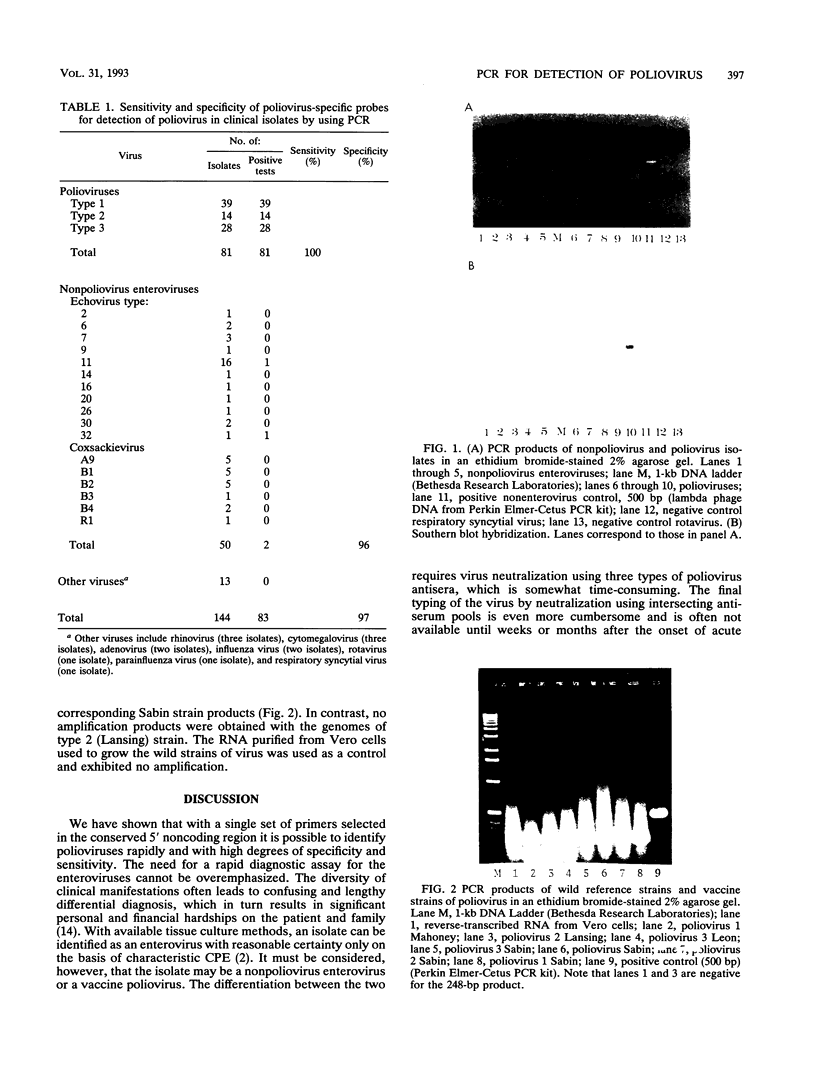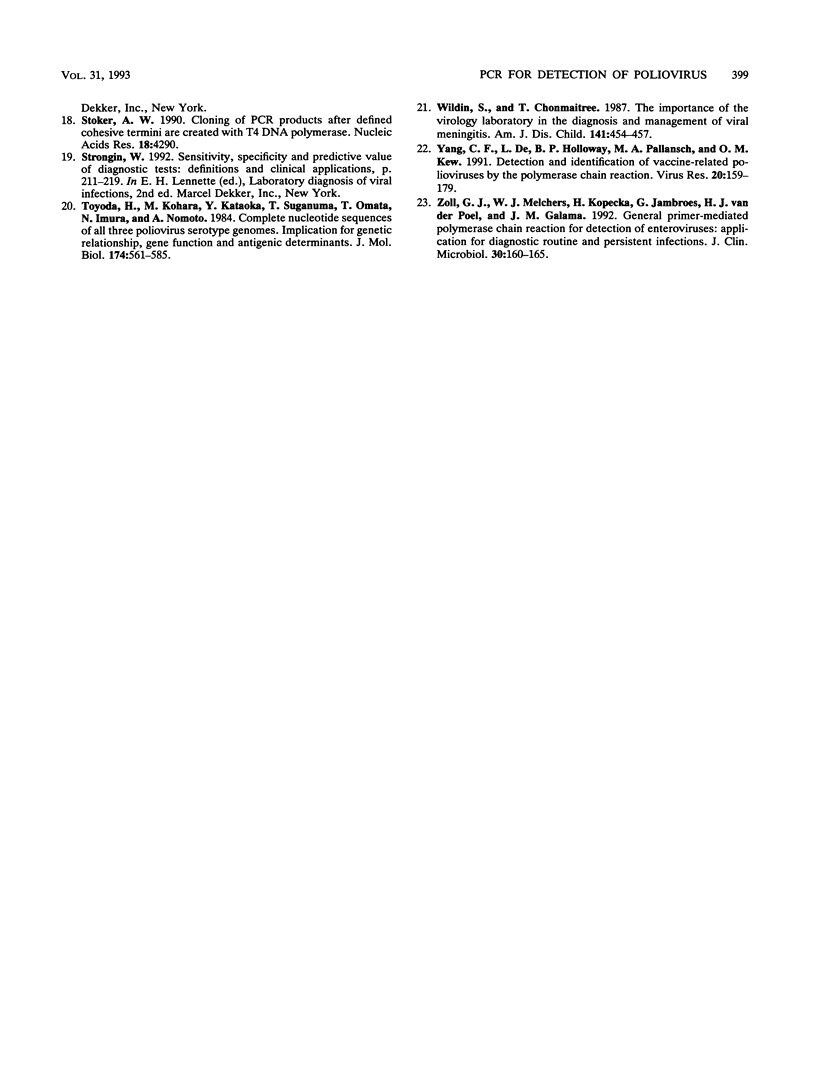Abstract
This report describes a rapid method of detection of poliovirus from viral isolates of clinical specimens using a single set of primers selected from the conserved 5' noncoding region of the poliovirus genome. Of the 144 clinical viral isolates examined, 81 were positive for polioviruses and 50 were positive for nonpoliovirus enteroviruses by tissue culture neutralization and infectivity. All 81 (100%) of the viral isolates identified as poliovirus by tissue culture infectivity were also positive by polymerase chain reaction. Of 50 nonpoliovirus enterovirus isolates found to be negative for poliovirus by tissue culture neutralization and infectivity, 48 were also negative by polymerase chain reaction. The high sensitivity (100%) and specificity (96%) of the primer set indicate that this assay has potential clinical applicability in the diagnosis of nonpoliovirus enterovirus infection.
Full text
PDF




Images in this article
Selected References
These references are in PubMed. This may not be the complete list of references from this article.
- Assaad F., Ljungars-Esteves K. World overview of poliomyelitis: regional patterns and trends. Rev Infect Dis. 1984 May-Jun;6 (Suppl 2):S302–S307. doi: 10.1093/clinids/6.supplement_2.s302. [DOI] [PubMed] [Google Scholar]
- Chonmaitree T., Ford C., Sanders C., Lucia H. L. Comparison of cell cultures for rapid isolation of enteroviruses. J Clin Microbiol. 1988 Dec;26(12):2576–2580. doi: 10.1128/jcm.26.12.2576-2580.1988. [DOI] [PMC free article] [PubMed] [Google Scholar]
- Hall C. B., Douglas R. G., Jr Clinically useful method for the isolation of respiratory syncytial virus. J Infect Dis. 1975 Jan;131(1):1–5. doi: 10.1093/infdis/131.1.1. [DOI] [PubMed] [Google Scholar]
- Herrmann E. C., Jr, Person D. A., Smith T. F. Experience in laboratory diagnosis of enterovirus infections in routine medical practice. Mayo Clin Proc. 1972 Aug;47(8):577–586. [PubMed] [Google Scholar]
- Hyypiä T., Auvinen P., Maaronen M. Polymerase chain reaction for human picornaviruses. J Gen Virol. 1989 Dec;70(Pt 12):3261–3268. doi: 10.1099/0022-1317-70-12-3261. [DOI] [PubMed] [Google Scholar]
- LIM K. A., BENYESH-MELNICK M. Typing of viruses by combinations of antiserum pools. Application to typing of enteroviruses (Coxsackie and ECHO). J Immunol. 1960 Mar;84:309–317. [PubMed] [Google Scholar]
- Lindberg A. M., Stålhandske P. O., Pettersson U. Genome of coxsackievirus B3. Virology. 1987 Jan;156(1):50–63. doi: 10.1016/0042-6822(87)90435-1. [DOI] [PubMed] [Google Scholar]
- Ogra P. L., Faden H. S., Abraham R., Duffy L. C., Sun M., Minor P. D. Effect of prior immunity on the shedding of virulent revertant virus in feces after oral immunization with live attenuated poliovirus vaccines. J Infect Dis. 1991 Jul;164(1):191–194. doi: 10.1093/infdis/164.1.191. [DOI] [PubMed] [Google Scholar]
- Petitjean J., Quibriac M., Freymuth F., Fuchs F., Laconche N., Aymard M., Kopecka H. Specific detection of enteroviruses in clinical samples by molecular hybridization using poliovirus subgenomic riboprobes. J Clin Microbiol. 1990 Feb;28(2):307–311. doi: 10.1128/jcm.28.2.307-311.1990. [DOI] [PMC free article] [PubMed] [Google Scholar]
- Rotbart H. A., Abzug M. J., Levin M. J. Development and application of RNA probes for the study of picornaviruses. Mol Cell Probes. 1988 Mar;2(1):65–73. doi: 10.1016/0890-8508(88)90045-x. [DOI] [PubMed] [Google Scholar]
- Rotbart H. A. Enzymatic RNA amplification of the enteroviruses. J Clin Microbiol. 1990 Mar;28(3):438–442. doi: 10.1128/jcm.28.3.438-442.1990. [DOI] [PMC free article] [PubMed] [Google Scholar]
- Rotbart H. A. Nucleic acid detection systems for enteroviruses. Clin Microbiol Rev. 1991 Apr;4(2):156–168. doi: 10.1128/cmr.4.2.156. [DOI] [PMC free article] [PubMed] [Google Scholar]
- Stoker A. W. Cloning of PCR products after defined cohesive termini are created with T4 DNA polymerase. Nucleic Acids Res. 1990 Jul 25;18(14):4290–4290. doi: 10.1093/nar/18.14.4290. [DOI] [PMC free article] [PubMed] [Google Scholar]
- Toyoda H., Kohara M., Kataoka Y., Suganuma T., Omata T., Imura N., Nomoto A. Complete nucleotide sequences of all three poliovirus serotype genomes. Implication for genetic relationship, gene function and antigenic determinants. J Mol Biol. 1984 Apr 25;174(4):561–585. doi: 10.1016/0022-2836(84)90084-6. [DOI] [PubMed] [Google Scholar]
- Wildin S., Chonmaitree T. The importance of the virology laboratory in the diagnosis and management of viral meningitis. Am J Dis Child. 1987 Apr;141(4):454–457. doi: 10.1001/archpedi.1987.04460040112030. [DOI] [PubMed] [Google Scholar]
- Yang C. F., De L., Holloway B. P., Pallansch M. A., Kew O. M. Detection and identification of vaccine-related polioviruses by the polymerase chain reaction. Virus Res. 1991 Jul;20(2):159–179. doi: 10.1016/0168-1702(91)90107-7. [DOI] [PubMed] [Google Scholar]
- Zoll G. J., Melchers W. J., Kopecka H., Jambroes G., van der Poel H. J., Galama J. M. General primer-mediated polymerase chain reaction for detection of enteroviruses: application for diagnostic routine and persistent infections. J Clin Microbiol. 1992 Jan;30(1):160–165. doi: 10.1128/jcm.30.1.160-165.1992. [DOI] [PMC free article] [PubMed] [Google Scholar]




